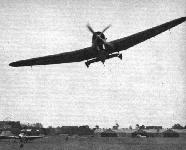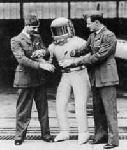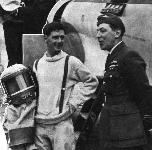
Описание
Страна : Великобритания
Год : 1936
Единственный экземпляр
Высотный экспериментальный самолет
Bristol Type 138
Итальянский пилот Ренато Донати на биплане Caproni Са 131 с двигателем Bristol Pegasus установил 11 апреля 1934 года новый мировой рекорд высоты - 14435 м. Вскоре это достижение было перекрыто французским самолетом Potez 506, достигшим высоты 14843 м.Тогда британцы решили вернуть себе рекорд, и в июне 1934 года фирма "Bristol" получила предложение построить два прототипа на базе проекта высотного экспериментального самолета, разработанного в ноябре 1933 года. В качестве силовой установки на нем предполагалось использовать двигатель Pegasus, оснащенный двухступенчатым нагнетателем. Конструктор Барнуэлл доработал под требования спецификации 2/34 проект, получивший фирменное обозначение Bristol Type 138A.
Самолет, проектирование которого завершилось в сентябре, представлял собой низкоплан деревянной конструкции. Для снижения массы шасси было сделано неубирающимся. Для пилота был разработан специальный гермокостюм. Ключевым элементом проекта был двигатель Pegasus PE.VIS с механическим нагнетателем (второй, дополнительный, нагнетатель мог крепиться к противопожарной перегородке и приводиться через гибкий вал и муфту).
Постройка Type 138 завершилась в начале 1936 года, и 11 мая в Филтоне бывший обладатель мирового рекорда высоты Сирил Авинс поднял его в воздух. В этом и еще двух полетах (16 и 22 мая) самолет был оснащен обычным двигателем Pegasus IV, вращавшим трехлопастный винт. После пребывания в Фарнборо, где проводились испытания кислородного оборудования, 15 августа самолет вернулся в Филтон для установки высотного мотора и четырехлопастного винта.
Для установления рекорда был выбран сквадрон-лидер Ф.Р.Д. Свейн, 5 сентября перегнавший Type 138A из Филтона в Фарнборо. Стартовав с этого аэродрома 28 сентября, он установил зарегистрированный ФАИ новый мировой рекорд высоты - 15 230 м - и приземлился в Низерэйвоне. Хотя в мае 1937 года на самолете Caproni Са 161 итальянцы установили новый рекорд 15 655 м, незначительные доработки Type 138A позволили превзойти и это достижение. Флайт-лейтенант М.Дж. Эддам 3 июня 1937 года поднялся на высоту 16440 м.
Варианты
Type 138B: второй прототип, на который для проведения сравнительных испытаний предполагалось установить снабженный турбонагнетателем двигатель Rolls-Royce Kestrel мощностью 500 л.с. (373 кВт). Хотя самолет был передан в Фарнборо в 1937 году, мотор на нем так и не установили
ТАКТИКО-ТЕХНИЧЕСКИЕ ХАРАКТЕРИСТИКИ
Bristol Type 138A
Тип: высотный экспериментальный самолет
Силовая установка: один радиальный двигатель Bristol Pegasus PE.VIS мощностью 500 л.с. (373 кВт)
Летные характеристики: максимальная скорость на высоте 13715 м - 285 км/ч; скороподъемность на высоте 12190 м - 436 м/мин; потолок (проектный) 16 459 м; продолжительность полета 2 ч 15 мин
Масса: пустого 1992 кг; максимальная взлетная 2409 кг
Размеры: размах крыла 20,12 м; длина 13,41 м; высота 3,12 м; площадь крыла 52,77 м2
Описание:
- Bristol Type 138
- Flight, October 1936
BRITAIN HIGHEST!
Фотографии
-
Jane's All the World Aircraft 1938 / 03 - All the world's aeroplanes
Регистрационный номер: K4879 [25] The Bristol 138A Monoplane (Bristol "Pegasus" engine) which put up a World's Height Record of 53,937 ft. on June 30, 1937.
-
Flight 1936-10 / Flight
Регистрационный номер: K4879 [25] -
Flight 1936-10 / Flight
Регистрационный номер: K4879 [25] -
Flight 1939-03 / Flight
Регистрационный номер: K4879 [25] The Bristol 138A high altitude record-breaking monoplane powered with a special Bristol Pegasus engine.
-
Flight 1936-10 / Flight Advertisements
Регистрационный номер: K4879 [25] -
Air Pictorial 1976-03
Регистрационный номер: K4879 [25] Перед кабиной пилота Type 138 было предусмотрено место для второго члена экипажа.
The Bristol 138A, K4879, which twice gained the World Altitude Record for Britain. On the second occasion, on 30th June 1937. F/Lt. M. J. Adam, taking off from R.A.F. Farnborough, reached a height of 53.937 ft. During the flight, which lasted 2 1/2 hours, the cockpit canopy cracked but Adam was saved from injury by his pressure suit; inflated with oxygen, it had a sealed helmet resembling early astronaut's gear. -
Flight 1936-10 / Flight
Регистрационный номер: K4879 [25] -
Flight 1937-07 / Flight
Регистрационный номер: K4879 [25] The triumphant Bristol 138 monoplane is stationed at the R.A.E., Farnborough, where it is seen flying here.
-
Flight 1940-02 / Flight
Регистрационный номер: K4879 [25] The Type 138A established two world's records, first of 49,967ft. and then of 53.937ft. 1936
-
Flight 1939-03 / Flight Advertisements
Регистрационный номер: K4879 [25] THE "BRISTOL" 138A High-altitude Monoplane has twice secured the World Altitude Record - the only machine in history with this distinction. A low-wing, stressed skin, wooden monoplane, fitted with a "Bristol" Pegasus engine
-
Мировая Авиация 102
Регистрационный номер: K4879 [25] 1936 год - 15223 м. Сквадрон-лидер Ф.Р.Д. Свейн на моноплане Bristol Type 138 (фото) установил мировой рекорд высоты 28 сентября 1936 года; через девять месяцев на этом же самолете флайт-лейтенант М.Дж. Адам установил новый рекорд - 16459 м.
-
Flight 1938-01 / Flight Advertisements
Регистрационный номер: K4879 [25] THE “BRISTOL” 138A High-altitude Monoplane has twice secured the World Altitude Record - the only machine in history with this distinction. A low-wing, stressed-skin, wooden monoplane, fitted with a “Bristol” Pegasus engine.
-
Flight 1936-10 / Flight Advertisements
Регистрационный номер: K4879 [25] -
Flight 1937-12 / Flight
Регистрационный номер: K4879 [25] On July 1 it was announced to the world that on the previous day Flt. Lt. Adam had recaptured the world's height record (53,937 ft.) on a special Bristol monoplane.
-
Flight 1937-01 / Flight
Регистрационный номер: K4879 [25] Sqn. Ldr. Swain and the Bristol 138 monoplane.
-
Jane's All the World Aircraft 1980 / Encyclopedia of Aviation - Aircraft A-Z - v2
Регистрационный номер: K4879 [25] Pressure suit worn by the pilots of the Bristol Type 138A.
-
Мировая Авиация 102
Регистрационный номер: K4879 [25] 1936 год - 15223 м. Сквадрон-лидер Ф.Р.Д. Свейн (в гермокостюме) на моноплане Bristol Type 138 установил мировой рекорд высоты 28 сентября 1936 года; через девять месяцев на этом же самолете флайт-лейтенант М.Дж. Адам установил новый рекорд - 16459 м.
-
Flight 1937-07 / Flight
Регистрационный номер: K4879 [25] Flt. Lt. Adam is seen discussing chances with Wing Cdr. J. W. Woodhouse.
-
Flight 1937-07 / Flight
Регистрационный номер: K4879 [25] Flt. Lt. Adam is insinuating himself into the pressure suit
-
Flight 1936-10 / Flight
Регистрационный номер: K4879 [25] HIGH-SCHOOL LESSON-I. "Now watch!" - "A little French chalk to get one's hand in." - "Now for the hat - most important."
-
Flight 1936-10 / Flight
Регистрационный номер: K4879 [25] HIGH-SCHOOL LESSON-II. "We screw up the belt clip to set our seal on the inner man." - "And so on board (very 'Things to Come' this bit)." - "The good old Hucks is still used where weight is a consideration."
-
Flight 1936-10 / Flight
Регистрационный номер: K4879 [25] HIGH-SCHOOL LESSON-III. "Per Pegasus ad Astra." - "Down to two feet once more" - "What d'you know about that?"
-
Flight 1937-05 / Flight
Регистрационный номер: K4879 [25] The Bristol 138 reached 50,000 ft. in 1936.
-
Flight 1937-07 / Flight
Регистрационный номер: K4879 [25] One of the least encouraging factors to Flt. Lt. Adam must have been his glimpse, on entering the cockpit, of the emergency instructions inscribed on the fuselage of the Bristol.
-
Flight 1936-10 / Flight
Numerous instruments enabled the "pressure-suited" pilot to know at any moment what his aeroplane and enginewere doing. The actual recording altimeters were carried in the wings, but an ordinary altimeter in the cockpit informed Sqn. Ldr. Swain of his height at any time during the flight.
-
Flight 1937-07 / Flight Advertisements
Регистрационный номер: K4879 [25]
- Фотографии






























